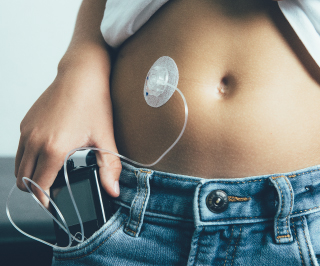
Click_and_Photo / iStock / Getty Images Plus
Two clinical trials that tested novel glucose monitoring systems underscore the challenges that developers face in crafting an optimal device to help manage variations in blood glucose. One study that used an algorithm to advise patients on titrating their insulin doses successfully reduced glycosylated hemoglobin (HbA1c) levels, but some experts questioned its practical applications in the real world. Another study encountered technical glitches with a hybrid closed loop insulin pump system that delivers insulin directly to patients.
Many patients with type 2 diabetes struggle to achieve optimal targets for glycemic control. Regular and frequent adjustments are necessary for insulin therapy to be effective, but in practice too much time elapses between clinic visits to make any necessary modifications. As a result, patients may experience a titration gap that could adversely affect their health, wrote the authors of a study published in Lancet that tested the d-Nav insulin guidance system, a hand-held device that uses a glucose meter and software to measure glucose, assess glucose patterns, and make an appropriate dose-by-dose insulin recommendations to the user.
The study included 181 adult participants from three U.S. diabetes centers in Detroit, Minneapolis, and Des Moines, Iowa, whose HbA1c levels ranged from 7.5% to 11% and had undergone the same insulin regimen for the past 3 months. Investigators divided them into two cohorts: an intervention group that received d-Nav insulin guidance in addition to healthcare professional support, and a control group that received only professional support. Regular follow-ups of the patients took place over a 6-month period.
Mean HbA1c levels averaged 8.6% in both groups at baseline, yet, the intervention group saw its HbA1c levels drop by 1% after 6 months, compared with 0.3% in the control patients, a significant difference, according to the investigators. In addition, “total daily insulin normalized to bodyweight was more than 60% higher in the intervention group compared with the control group,” they wrote. The algorithm approach ended up adjusting insulin doses about 1.1 times per week in this group. Frequency of hypoglycemic events was similar in both groups, however.
The study’s authors recommended testing d-Nav insulin guidance system in a larger cohort across healthcare systems to further study its effectiveness and cost benefits.
“Faced with increasing pressures and demands on primary care, a substantial niche seems likely for technology to help in type 2 diabetes,” wrote Mark L. Evans, MD and Rajna Golubic, MD, PhD in a related editorial. Yet, they questioned the feasibility of some of the techniques used in the Lancet study. Titrating insulin doses on average about 1.1 times weekly, for example, would be “pragmatically unachievable” in practice, they wrote in the editorial.
Study team members frequently checked in with the participants over the 6-month study period, sometimes in face-to-face meetings. “In the real world, if such frequency of contact was an essential requirement for success of the system, it would be challenging for many services,” noted Evans and Golubic. They also questioned how comfortable patients and their doctors would be in allowing an algorithm to determine their insulin doses.
Another study faced some challenges with insulin management technology. At this year’s Endocrine Society meeting in New Orleans (ENDO 2019) Gregory Goodwin, MD, a senior associate physician in medicine at Boston Children’s Hospital in Boston, discussed what happened when he and his team prescribed the Medtronic MiniMed 670G hybrid closed loop insulin pump system to 83 children and young adults with type 1 diabetes.
Approved for use in children by the Food and Drug Administration in 2018, the device automatically delivers basal or background insulin to help patients control daily blood glucose variations. Study participants had to know how to use continuous glucose monitors or insulin pumps, and received training on the MiniMed system from the manufacturer. Nevertheless, 19% of participants had to stop using the device after several months due to technical problems. “Calibration requirements, problems with sensor durability or adhesion, skin irritation, and forced exits from auto mode were common areas of difficulty,” Goodwin reported in his study abstract.
Among the patients who continued to use auto mode, the researchers observed wide ranges in auto mode times. However, 58 of these patients saw their HbA1c decrease collectively by 0.27% after 97 days. “In conclusion, our data supports the observation that closed loop insulin delivery in subjects that are successful in using the technology improves glucose control (reduces HbA1c). Additional work is needed to understand barriers to successful implementation of technology,” concluded Goodwin.